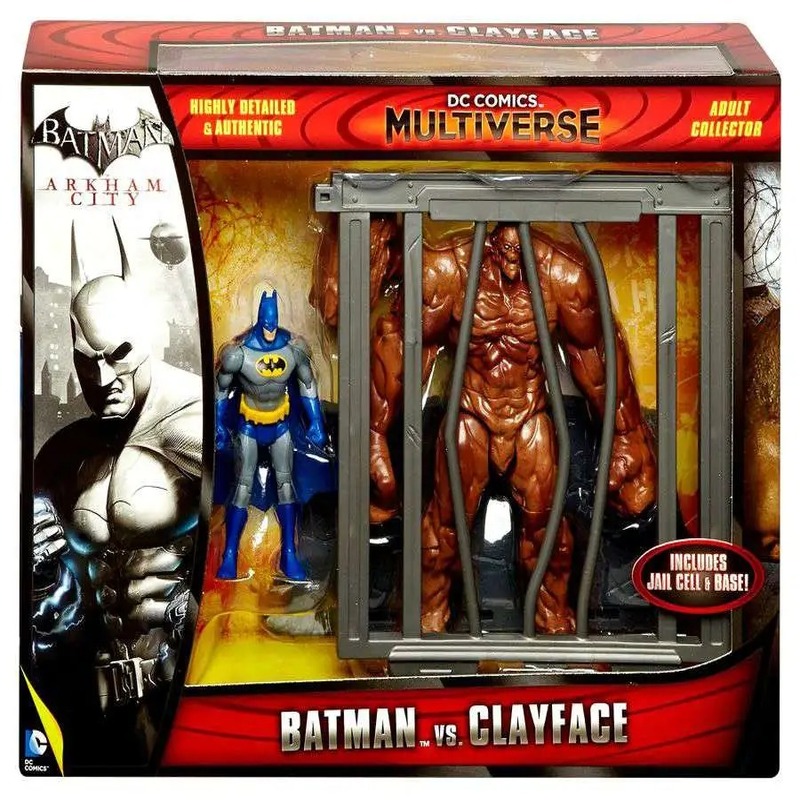The Origin of Clayface: A Villain’s Tale
The story of Batman Clayface begins as a tale of tragedy and transformation. Initially, Clayface was not one, but several characters over time, each with their own backstory. The first to assume the mantle was Basil Karlo, a disgraced actor who turned to crime. Driven by envy and the fear of becoming irrelevant, he used the persona of Clayface to terrorize Gotham City.
Later, the Clayface identity was passed to others, each furthering the villain’s legacy. Matt Hagen, an adventurer, became the second Clayface after an encounter with a mysterious radioactive protoplasm. His powers were vast, allowing him to shapeshift flawlessly into any form, including Batman himself. Other versions, like Preston Payne and Sondra Fuller, added more layers to the Clayface persona, uniting the terror of a shapeshifter with poignant human struggles. Their origins grounded in science fiction and horror, they illustrate the varied and rich tapestry that makes up the legacy of this formidable adversary to Batman.
With each iteration, the backstory of this villain deepened, reflecting the fears and fascinations of society at the time. Whether as a metaphor for the loss of self in the pursuit of fame or as a victim of uncontrolled scientific experimentation, Clayface represents a character as complex as he is terrifying. The origin of Clayface is a testament to the enduring nature of formidable foes in the Batman universe.
Understanding Clayface: Powers and Abilities
Clayface is a formidable adversary for Batman, with a power set that makes him incredibly difficult to defeat. The cornerstone of Clayface’s abilities is his shapeshifting, which allows him to transform into almost any person or object. This makes him a master of disguise and infiltration. His malleable form is not just for appearance; he can also mimic voices, textures, and even clothing.
Another terrifying aspect of Clayface’s powers is his size and strength manipulation. He can swell to immense sizes, providing him with superhuman strength to overpower foes or to cause destruction on a large scale. Conversely, he can also shrink or stretch his body to escape through the smallest of openings, making containment a true challenge.
Due to his clay-like body, Clayface is also able to absorb blows that would severely injure others. This gives him a certain level of invulnerability, allowing him to recover quickly from attacks. Combined with the ability to regenerate damaged or lost body parts, this makes him a persistent threat during any encounter.
Lastly, Clayface can use his body as a weapon, forming hardened clay projectiles or wielding limbs as clubs. In close combat, he can envelop and suffocate opponents, altering his density to either trap them or crush them under his weight. These powers create a unique challenge for Batman, who must outthink rather than outfight this mutable menace.
The arsenal of powers at Clayface’s disposal makes him not only a physical threat to Batman but also a psychological one. Batman must constantly adapt his tactics to confront the ever-changing nature of Clayface’s abilities, ensuring that every battle with him is unpredictable and dangerous.

Batman vs. Clayface: Epic Showdowns in Gotham
Whenever Batman faces Clayface, it’s a clash of wits and wills in Gotham’s shadowy corners. Each battle is a standout moment, showcasing the Caped Crusader’s strategic mind against Clayface’s mutable form. Through the years, their encounters have ranged from hand-to-hand combat to high-tech traps.
One epic showdown involved Batman using freeze technology to solidify Clayface, temporarily halting his shape-shifting powers. Another memorable battle saw Batman exploit Clayface’s weakness to water, causing his form to lose cohesion. Batman also relies on his utility belt, full of gadgets, to create electromagnetic fields or harness electricity, both effective against the villain’s malleable body.
At times, Batman has had to protect innocent bystanders caught in the crossfire. His mission is not just to defeat Clayface, but to ensure the safety of Gotham’s citizens. This means quick thinking and non-lethal strategies are always at the forefront of their battles.
Though Batman often triumphs, each victory comes with the knowledge that Clayface will return, perhaps with new tactics or strengths. This forces Batman to remain ever-vigilant, ready to adapt and face the challenge once more. As such, the ongoing battle between Batman and Clayface represents a dynamic rivalry that continues to capture the imagination of fans worldwide.
The Tragedy of Clayface: Exploring the Character’s Motivation
Beyond his menacing facade, Clayface harbors deep-seated motivations fueling his criminal acts. His origins speak of personal agonies, and his actions often reflect a struggle for identity and acceptance. Each incarnation of Clayface has a tragic backstory that pushes them towards villainy.
Basil Karlo, the original Clayface, saw his illustrious acting career crumble, igniting a vengeful desire to remain in the spotlight, no matter the cost. His envy warped into a sinister persona that let him claim the fame he lost, all while striking fear into the hearts of his audience.
For Matt Hagen, his Clayface identity offered an escape from mortality. Having gained powers from a radioactive substance, he faces the constant fight to maintain his humanity, sometimes succumbing to the baser instincts of survival and power that his new form enabled.
The tales of Preston Payne and Sondra Fuller are laced with isolation and rejection. Payne, cursed with an ability that caused physical pain to those he touched, turned to crime in desperation. Fuller, altered by a shapeshifting serum, found herself trapped in a life she did not choose.
These characters, while diverse, share common ground in their tragic origins. Each turns to villainy in an attempt to cope with or combat their given circumstances. Clayface’s story is one of loss, heartache, and the constant pursuit of a lost self, driving the actions that continually pit him against Batman.
Their motivations make them sympathetic at times, adding complexity to their role as a villain. It is this complexity that makes battles with Batman more than physical confrontations; they are clashes of deeply conflicted personalities. In understanding the tragedy behind Clayface, one can see that he is not just an adversary, but a character steeped in the human experience of suffering and the pursuit of redemption, however misguided it may be.
Clayface in Different Media: From Comics to Animation
Clayface has leaped from comic pages to screens, captivating audiences across various media. Initially, this complex villain haunted the panels of Batman comics, portraying his evolution and battles with the Dark Knight. Comics have always been Clayface’s primary home, where his story grows with each issue. Here, artists and writers explore his powers and psyche in depth, constantly adding new layers to his character.
Animation brought a new dimension to Clayface, particularly in the acclaimed ‘Batman: The Animated Series’. His malleable form and haunting story translated beautifully to animation, offering dynamic visual storytelling. The series depicted not only his formidable powers but also his tragic nature, providing deeper emotional connections for viewers. Voice actors gave life to his multiple personalities, enhancing his presence beyond the static images of comic books.
Feature films and video games have also seen portrayals of this shapeshifting menace. Though less frequent, these appearances introduce Clayface to wider audiences, often highlighting his most terrifying abilities. In video games, players experience the thrill and challenge of combating Clayface firsthand, testing their strategies against his shapeshifting tactics.
Through each medium, Clayface’s essence remains consistent: a tragic figure with immense power, posing a unique challenge to Batman. As he shifts between media, he retains the core elements that make him a profound and enduring part of the Batman universe. His presence in different media ensures that the Clayface dilemma continues to intrigue and challenge fans, old and new alike.

The Psychology of Clayface: Insights into a Shapeshifting Menace
Clayface’s ability to shapeshift extends beyond mere physical transformation. It also deeply impacts his psychology. As he morphs into different forms, the line between his true self and the personas he adopts can blur. This raises questions about his true identity and the psychological struggles that come with such power.
This villain often uses his shapeshifting abilities as a defense mechanism. He can hide behind other faces and lives due to fear of facing his own reality. The continual change in form may be a way to escape from his past traumas and disappointments. For many, the thought of losing oneself in such a way is a fear as old as time itself.
The shifting nature of Clayface’s identity can cause inner turmoil and confusion. He may experiment with numerous identities searching for acceptance or a sense of belonging. The power that once seemed a gift may often feel like a curse, locking him in a cycle of continuous transformation with no end.
His psychological complexity adds to the challenge Batman faces. It’s not just about stopping a villain; it’s about understanding an individual caught in a web of his own powers. Batman, known for his detective skills, often tries to unravel the mental puzzle that is Clayface. He knows that beating him is as much about outsmarting his tactics as it is about confronting his inner demons.
As readers or viewers, we witness a character who is both antagonist and victim. Clayface’s battles with Batman are not just physical but existential. His struggles hold up a mirror to the human condition, where identity and the search for self can be as shapeless and malleable as the clay he embodies.
Batman’s Tactics: Outsmarting a Shapeshifter
Batman’s nimble mind is key when tackling Clayface’s daunting abilities. The Dark Knight often must outmaneuver rather than overpower his malleable foe. Each battle with Clayface requires fresh strategies, as the villain’s shapeshifting powers render previous tactics obsolete.
Foremost in Batman’s approach is his reliance on advanced technology. Specialized gear from his utility belt is frequently adapted to combat Clayface’s form-changing skills. Batman also employs investigative prowess to anticipate Clayface’s moves. By analyzing patterns in the villain’s behavior, Batman can often stay one step ahead.
Intelligence is leveraged to exploit Clayface’s vulnerabilities. Elements like extreme heat or cold are used to disrupt his malleable physiology. Batman might also deploy chemical compounds that counteract Clayface’s ability to coalesce. Additionally, Batman leverages the environment, turning the terrain to his advantage against the shapeshifter.
Deception plays a role too. Batman might use decoys or misdirection, playing on Clayface’s emotional triggers. By understanding the villain’s psyche, Batman crafts psychological warfare to create openings for attack. He challenges the villain’s sense of identity, which can lead to critical mistakes.
Batman’s tactics are a testament to his adaptable nature as Gotham’s protector. They emphasize the importance of continually updating strategies to face ever-evolving threats. In facing Clayface, the Caped Crusader teaches us that, even against shifting odds, determination and ingenuity can pave the way for victory.

The Evolution of Clayface: How the Character Has Changed Over Time
Clayface has evolved greatly since his first appearance. This character’s journey reflects changes in comic book storytelling and societal trends. Each new Clayface adds something unique to the mythos.
The early Clayface, Basil Karlo, was a man driven by jealousy and revenge. His story was simpler, focused on fear and intimidation. As comics matured, so did Clayface. Matt Hagen introduced superpowers to the mix, adding complexity and versatility to the character.
Later versions like Preston Payne and Sondra Fuller brought in themes of isolation and tragedy. Their backstories offered depth and pathos, pulling readers into more emotional narratives. The essence of Clayface shifted from a straightforward villain to a tragic, multifaceted character.
Modern interpretations of Clayface often explore the psychological consequences of his abilities. With each iteration, writers delve deeper into the character’s psyche. We see more of his inner conflict and how his powers impact his identity.
Art style changes have also played a part. As visual storytelling has evolved, so has the depiction of Clayface’s powers. His shapeshifting is now more detailed and dynamic than ever before, truly showcasing the breadth of his abilities.
Clayface’s evolution is a mirror to comic book history. He started as a simple villain but grew into a complex figure. He reflects our changing times and storytelling tastes. His transformations—both literal and figurative—are a testament to the ever-evolving landscape of the Batman universe.





